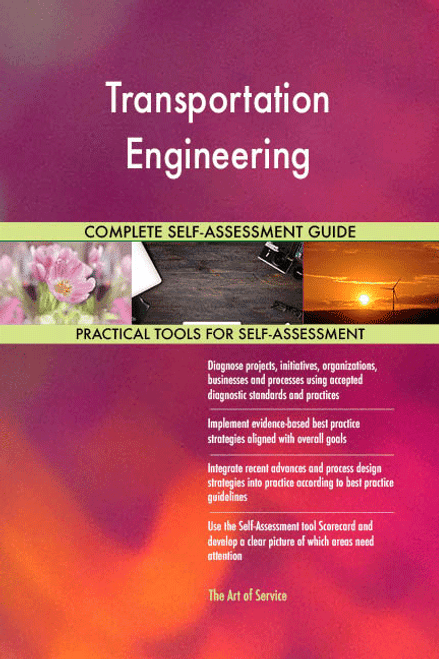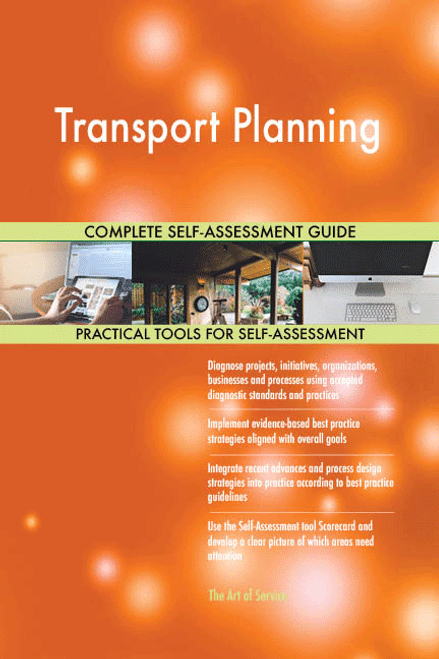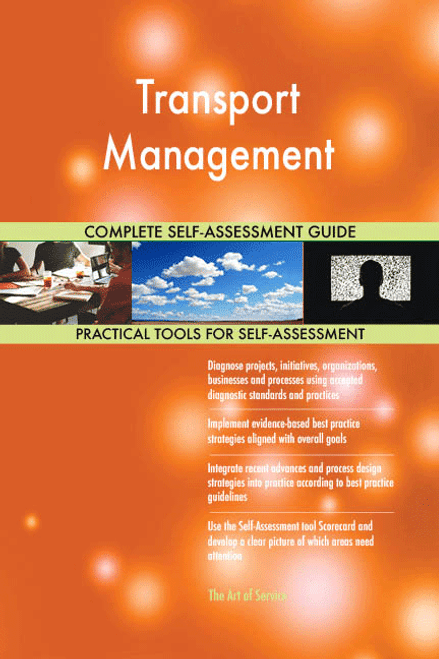Direct Transportation Engineering: work cross functionally across client business units, program and Product Management, and Agile teams.
More Uses of the Transportation Engineering Toolkit:
- Establish that your group performs Transportation Engineering work in one or more functional areas as planning, project development and design.
- Manage Transportation Engineering: complete high level solutions and designs, estimates, Technical Writing and cost review for telecommunications, smart organization and intelligent transportation system (its) projects.
- Support the development of visual dashboards of transportation programming and planning information.
- Be accountable for working closely with surface industry partners to coordinate national surface transportation Security Operations development.
- Supply Chain management, Transportation and Logistics, and Production Support outsourcing solutions are among the many services provided to customers.
- Be accountable for applying fundamental professional principles and practices related Transportation and Logistics.
- Manage work with cross functional partners to continuously improve forecast accuracy, Demand Planning efficiency, transportation routes and loading, and Customer Service.
- Ensure your organization continuously sets the standard for excellence in transportation security through its people, processes, technologies and use of intelligence to drive operations.
- Ensure you accumulate; lead and coordinate design and innovation efforts to develop optimal solutions for the Transportation Network through equipment specification, Material Flow, Process Design, site layout, and Intellectual Property considerations.
- Be accountable for conducting analysis of transportation security Programs And Policies that support Industry Engagement outreach programs.
- Ensure you oversee; lead and coordinate design and innovation efforts to develop optimal solutions for the Transportation Network through equipment specification, Material Flow, Process Design, site layout, and Intellectual Property considerations.
- Formulate, interpret and disseminate technical guidance based upon regulations, directives, and Standard Operating Procedures (SOPs), pertaining to facility and transportation management.
- Develop an innovation ecosystem to accelerate sustainable transportation solutions adoption, working with internal and external groups and partners.
- Lead Transportation Engineering: work directly with the sales department to determine the most cost effective distribution solution for finished goods transportation to customers.
- Perform Transportation Network analysis and create network simulation models.
- Collaborate with other planners/engineers across the government and other partner organizations to research, analyze, or resolve complex transportation design issues.
- Collaborate with your Warehouse and Transportation teams to support a smooth flow of product in and out of the volunteer production area.
- Direct Transportation Engineering: work closely with external Logistics and Management staff to optimize efficiency, productivity, and workflow processes associated with the day to day transportation operations.
- Confirm your business ensures consistency with your organizations transportation policies and goals.
- Standardize Transportation Engineering: work directly with sales department to determine most cost effective distribution solution for finished goods transportation to customers.
- Ensure you accrue; lead and coordinate design and innovation efforts to develop optimal solutions for the Transportation Network through equipment specification, Material Flow, Process Design, site layout, and Intellectual Property considerations.
- Control Transportation Engineering: complete high level solutions and designs, estimates, Technical Writing and cost review for telecommunications, smart organization and intelligent transportation system (its) projects.
- Systematize Transportation Engineering: in alignment with Strategic Sourcing, provide analysis to determine the appropriate transportation costs, times and impacts for new products introduction.
- Arrange that your venture serves as a functional expert in logistics, transportation and Warehouse Management.
- Ensure your operation serves as a functional expert in logistics, transportation and Warehouse Management.
- Ensure you consider; lead Strategic Planning and forecasting for transportation operations.
- Ensure you enhance; lead initiatives to improve Transportation and Logistics services with a focus on speed to market, quality, reliability, execution to plan and Customer Service.
- Audit Transportation Engineering: Warehouse Management systems, transportation management systems, Order Management systems, etc.
- Confirm your team complies; principles and practices of capital project development as applied to the environmental clearance, design, cost estimating, and construction of a wide variety of transportation systems.
- Assure your corporation prepares plans, estimates, and specifications to design transportation improvements.
- Ensure you forecast; chartered to function in close interaction with Product Engineering and collaborate with services sales teams to drive Solution Adoption.
- Ensure your operation complies; monitors, proactively develops and delivers collection and loss mitigation training in a constantly changing environment.
Save time, empower your teams and effectively upgrade your processes with access to this practical Transportation Engineering Toolkit and guide. Address common challenges with best-practice templates, step-by-step Work Plans and maturity diagnostics for any Transportation Engineering related project.
Download the Toolkit and in Three Steps you will be guided from idea to implementation results.
The Toolkit contains the following practical and powerful enablers with new and updated Transportation Engineering specific requirements:
STEP 1: Get your bearings
Start with...
- The latest quick edition of the Transportation Engineering Self Assessment book in PDF containing 49 requirements to perform a quickscan, get an overview and share with stakeholders.
Organized in a Data Driven improvement cycle RDMAICS (Recognize, Define, Measure, Analyze, Improve, Control and Sustain), check the…
- Example pre-filled Self-Assessment Excel Dashboard to get familiar with results generation
Then find your goals...
STEP 2: Set concrete goals, tasks, dates and numbers you can track
Featuring 999 new and updated case-based questions, organized into seven core areas of Process Design, this Self-Assessment will help you identify areas in which Transportation Engineering improvements can be made.
Examples; 10 of the 999 standard requirements:
- How do you track customer value, profitability or financial return, organizational success, and sustainability?
- Do you say no to customers for no reason?
- What are you attempting to measure/monitor?
- In the past few months, what is the smallest change you have made that has had the biggest positive result? What was it about that small change that produced the large return?
- How do you define the solutions' scope?
- Where do you need Transportation Engineering improvement?
- Is there a clear Transportation Engineering case definition?
- How can you manage cost down?
- What gets examined?
- What does a Test Case verify?
Complete the self assessment, on your own or with a team in a workshop setting. Use the workbook together with the self assessment requirements spreadsheet:
- The workbook is the latest in-depth complete edition of the Transportation Engineering book in PDF containing 994 requirements, which criteria correspond to the criteria in...
Your Transportation Engineering self-assessment dashboard which gives you your dynamically prioritized projects-ready tool and shows your organization exactly what to do next:
- The Self-Assessment Excel Dashboard; with the Transportation Engineering Self-Assessment and Scorecard you will develop a clear picture of which Transportation Engineering areas need attention, which requirements you should focus on and who will be responsible for them:
- Shows your organization instant insight in areas for improvement: Auto generates reports, radar chart for maturity assessment, insights per process and participant and bespoke, ready to use, RACI Matrix
- Gives you a professional Dashboard to guide and perform a thorough Transportation Engineering Self-Assessment
- Is secure: Ensures offline Data Protection of your Self-Assessment results
- Dynamically prioritized projects-ready RACI Matrix shows your organization exactly what to do next:
STEP 3: Implement, Track, follow up and revise strategy
The outcomes of STEP 2, the self assessment, are the inputs for STEP 3; Start and manage Transportation Engineering projects with the 62 implementation resources:
- 62 step-by-step Transportation Engineering Project Management Form Templates covering over 1500 Transportation Engineering project requirements and success criteria:
Examples; 10 of the check box criteria:
- Cost Management Plan: Eac -estimate at completion, what is the total job expected to cost?
- Activity Cost Estimates: In which phase of the Acquisition Process cycle does source qualifications reside?
- Project Scope Statement: Will all Transportation Engineering project issues be unconditionally tracked through the Issue Resolution process?
- Closing Process Group: Did the Transportation Engineering Project Team have enough people to execute the Transportation Engineering project plan?
- Source Selection Criteria: What are the guidelines regarding award without considerations?
- Scope Management Plan: Are Corrective Actions taken when actual results are substantially different from detailed Transportation Engineering project plan (variances)?
- Initiating Process Group: During which stage of Risk planning are risks prioritized based on probability and impact?
- Cost Management Plan: Is your organization certified as a supplier, wholesaler, regular dealer, or manufacturer of corresponding products/supplies?
- Procurement Audit: Was a formal review of tenders received undertaken?
- Activity Cost Estimates: What procedures are put in place regarding bidding and cost comparisons, if any?
Step-by-step and complete Transportation Engineering Project Management Forms and Templates including check box criteria and templates.
1.0 Initiating Process Group:
- 1.1 Transportation Engineering project Charter
- 1.2 Stakeholder Register
- 1.3 Stakeholder Analysis Matrix
2.0 Planning Process Group:
- 2.1 Transportation Engineering Project Management Plan
- 2.2 Scope Management Plan
- 2.3 Requirements Management Plan
- 2.4 Requirements Documentation
- 2.5 Requirements Traceability Matrix
- 2.6 Transportation Engineering project Scope Statement
- 2.7 Assumption and Constraint Log
- 2.8 Work Breakdown Structure
- 2.9 WBS Dictionary
- 2.10 Schedule Management Plan
- 2.11 Activity List
- 2.12 Activity Attributes
- 2.13 Milestone List
- 2.14 Network Diagram
- 2.15 Activity Resource Requirements
- 2.16 Resource Breakdown Structure
- 2.17 Activity Duration Estimates
- 2.18 Duration Estimating Worksheet
- 2.19 Transportation Engineering project Schedule
- 2.20 Cost Management Plan
- 2.21 Activity Cost Estimates
- 2.22 Cost Estimating Worksheet
- 2.23 Cost Baseline
- 2.24 Quality Management Plan
- 2.25 Quality Metrics
- 2.26 Process Improvement Plan
- 2.27 Responsibility Assignment Matrix
- 2.28 Roles and Responsibilities
- 2.29 Human Resource Management Plan
- 2.30 Communications Management Plan
- 2.31 Risk Management Plan
- 2.32 Risk Register
- 2.33 Probability and Impact Assessment
- 2.34 Probability and Impact Matrix
- 2.35 Risk Data Sheet
- 2.36 Procurement Management Plan
- 2.37 Source Selection Criteria
- 2.38 Stakeholder Management Plan
- 2.39 Change Management Plan
3.0 Executing Process Group:
- 3.1 Team Member Status Report
- 3.2 Change Request
- 3.3 Change Log
- 3.4 Decision Log
- 3.5 Quality Audit
- 3.6 Team Directory
- 3.7 Team Operating Agreement
- 3.8 Team Performance Assessment
- 3.9 Team Member Performance Assessment
- 3.10 Issue Log
4.0 Monitoring and Controlling Process Group:
- 4.1 Transportation Engineering project Performance Report
- 4.2 Variance Analysis
- 4.3 Earned Value Status
- 4.4 Risk Audit
- 4.5 Contractor Status Report
- 4.6 Formal Acceptance
5.0 Closing Process Group:
- 5.1 Procurement Audit
- 5.2 Contract Close-Out
- 5.3 Transportation Engineering project or Phase Close-Out
- 5.4 Lessons Learned
Results
With this Three Step process you will have all the tools you need for any Transportation Engineering project with this in-depth Transportation Engineering Toolkit.
In using the Toolkit you will be better able to:
- Diagnose Transportation Engineering projects, initiatives, organizations, businesses and processes using accepted diagnostic standards and practices
- Implement evidence-based Best Practice strategies aligned with overall goals
- Integrate recent advances in Transportation Engineering and put Process Design strategies into practice according to Best Practice guidelines
Defining, designing, creating, and implementing a process to solve a business challenge or meet a business objective is the most valuable role; In EVERY company, organization and department.
Unless you are talking a one-time, single-use project within a business, there should be a process. Whether that process is managed and implemented by humans, AI, or a combination of the two, it needs to be designed by someone with a complex enough perspective to ask the right questions. Someone capable of asking the right questions and step back and say, 'What are we really trying to accomplish here? And is there a different way to look at it?'
This Toolkit empowers people to do just that - whether their title is entrepreneur, manager, consultant, (Vice-)President, CxO etc... - they are the people who rule the future. They are the person who asks the right questions to make Transportation Engineering investments work better.
This Transportation Engineering All-Inclusive Toolkit enables You to be that person.
Includes lifetime updates
Every self assessment comes with Lifetime Updates and Lifetime Free Updated Books. Lifetime Updates is an industry-first feature which allows you to receive verified self assessment updates, ensuring you always have the most accurate information at your fingertips.







